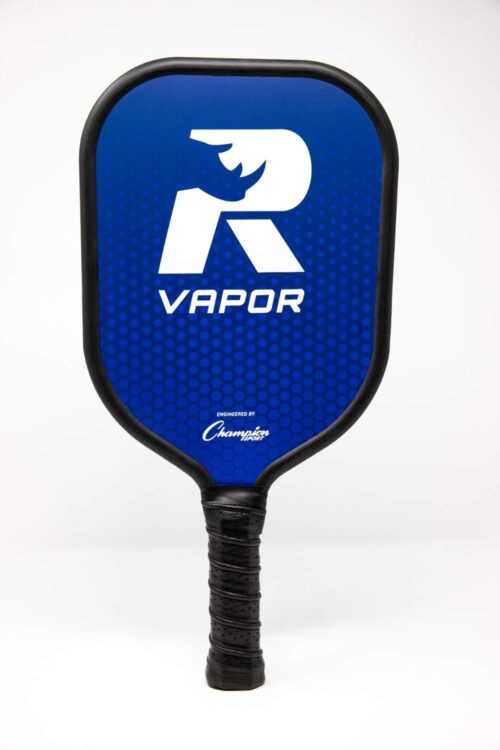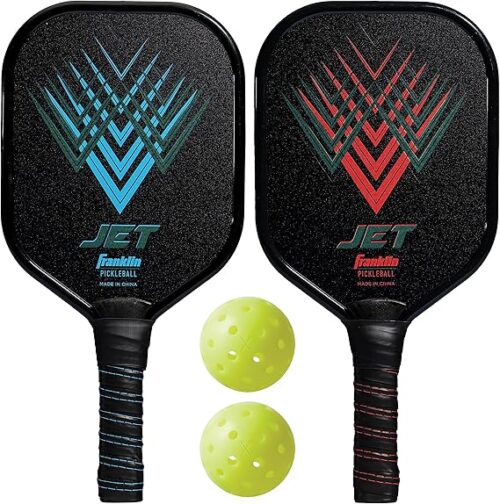In this article, you will learn everything you need to know about the performance of aluminum pickleball paddles, including their advantages and disadvantages, as well as how they can be compared to other common types of paddles. The purpose of this article is to assist you in determining whether or not aluminum should be included in your collection of paddles, regardless of whether you are a beginner or an experienced player wishing to experiment.
What are Aluminum Pickleball Paddles?

Aluminum pickleball paddles typically feature an aluminum honeycomb core sandwiched between aluminum or composite-facing materials. Unlike wooden paddles that dominated early pickleball history, aluminum paddles introduced a lighter, more responsive option that helped the sport evolve toward faster, more dynamic play.
Material Construction
Core: Many aluminum paddles have a honeycomb aluminum core for lightweight strength.
Face: Some use a full aluminum hitting surface, while others combine it with graphite or polymer coatings for better touch.
The construction of aluminum paddles involves several key components.
Advantages of Aluminum Paddles:
1. Excellent Durability
Aluminum paddles withstand impacts and rough handling better than most other paddle materials. For players who frequently drop their equipment or play in challenging environments, aluminum offers superior resistance to:
- Edge guard separation
- Face cracking or delamination
- Core structural failures
- Damage from temperature extremes
2. Budget-Friendly Price Point
Quality aluminum paddles remain available at significantly lower prices than composite, fiberglass, or graphite alternatives. This affordability makes them particularly appealing for:
- Players just starting their pickleball journey
- Facilities providing loaner equipment
- Families outfitting multiple players
- Those uncertain about their long-term commitment to the sport
3. Natural Power Generation
The rigidity and density of aluminum efficiently transfer energy from player to ball, creating power with minimal effort. Power-oriented playing styles benefit from:
- Enhanced drive shot velocity
- Powerful serves with less exertion
- Strong overhead smashes
- Effective passing shots
4. Minimal Maintenance Requirements
Aluminum paddles require less careful handling than more delicate materials, making them ideal for casual players who don’t want to worry about special care routines. Their resilience means:
- Less concern about temperature exposure
- Minimal performance impact from humidity
- Resistance to cosmetic damage
- Longer useful lifespan with rough handling
Disadvantages of Aluminum Paddles:
1. Limited Control and Touch
Aluminum paddles provide less precise feedback during ball contact, making fine control more challenging. Players often struggle with:
- Inconsistent dinking performance
- Reduced spin generation
- Less predictable third-shot drops
- Difficulty executing touch volleys
For players seeking enhanced control without sacrificing power, Some paddles offer an excellent alternative with its DuPont Kevlar surface and 16mm reactive honeycomb polymer core, delivering exceptional ball response across all shot types.
2. Increased Weight
Most aluminum paddles weigh more than their modern counterparts, potentially causing:
- Faster arm fatigue during extended play
- Slower reaction times at the kitchen line
- Reduced maneuverability for quick exchanges
- More strain on joints and tendons
3. Noise Level
Aluminum paddles generally produce more noise on ball impact than polymer core paddles, creating a distinctive “ping” sound that some players and communities find disruptive. Noise considerations include:
- Potential community complaints in residential settings
- Difficulty in sound-sensitive environments
- More noticeable play in multi-court facilities
- Possible restrictions at some venues with noise policies
4. Limited Sweet Spot
Compared to modern paddles, aluminum options typically feature smaller sweet spots that reduce consistency across the paddle face. Off-center hits often result in:
- Significantly reduced power
- Uncomfortable vibration transfer to the arm
- Less accurate shot placement
- Inconsistent ball response
Aluminum Pickleball Paddles:
Here are some aluminum pickleball paddles recommendations.
1. Champion Sports Rhino Pickleball Paddles:

POWER AND CONTROL: A dual-plated aluminum surface and honeycomb core make it strong and responsive
PADDED HANDLE: The 6” EVA handle has a soft cushioned grip to provide maximum comfort on every hit
DURABLE EDGE GUARD: A plastic edge guard surrounds and protects the paddle during games and on the way to the court.
EASY TO SWING: Weighing 9.6-9.8 oz, the paddles are still lightweight enough for any player to use
FOR ALL PLAYERS: A high-quality paddle for players of all skill levels and any practice or game
2. Franklin Sports Beginner Pickleball Sets:

The Jet pickleball starter set comes complete with (2) aluminum pickleball paddles and (2) X-40 outdoor pickleball, so you have everything you need for a two-player game.
DURABLE PADDLES: The Jet aluminum pickleball paddles are built with a strong aluminum core and a non-slip comfort grip to provide premium performance and durability match after match
X-40 PICKLEBALLS: This set comes with (2) X-40 outdoor pickleball, made for ultimate precision and durability as the official pickleball of USA Pickleball (USAPA)
GREAT FOR BEGINNERS: This all-in-one, 2-player starter set is perfect for pickleball beginners to stock up on all the equipment needed to hit the courts and join the fun!
USA PICKLEBALL APPROVED: Both the Jet aluminum pickleball paddles and X-40 outdoor pickleball are approved for competitive and tournament play by USA Pickleball (USAPA)
3. Third Shot Drop ALUMINUM CORE PICKLEBALL PADDLE:

This paddle is ideal for medium-hitting touch players looking for a paddle with a bit more power to put the ball away. The Aluminum core provides an outstanding “touch.” The ball pops off just a bit slower, which gives players an extra edge of maneuverability. You may lose a bit of power with aluminum compared to the other cores. The Composite surface takes full advantage of the latest aerospace materials composite technology, featuring an incredible combination of touch, feel, and strength. It provides players with a bit more power than the other surfaces.
Why Polymer & Carbon Fiber replaced Aluminum:
The shift from aluminum to polymer and carbon fiber in pickleball paddles stems from a collective demand for improved playability, elevated comfort, and superior versatility. As players continually seek advancements in sporting equipment that enhance their game, polymers, and carbon fibers emerge as the frontrunners thanks to their ability to combine lightweight features with outstanding performance characteristics, all while providing a more tailored experience suited to modern-age athletes.
Superior feel & comfort
When it comes to playing comfort, polymer and carbon fiber, paddles offer distinct advantages over their aluminum counterparts. These composites are designed to absorb shock more efficiently, translating to reduced stress on the player’s hand and wrist. Here’s why they stand out:
Enhanced Shock Absorption: The materials help mitigate vibrations, ensuring players feel less fatigued over prolonged play durations.
Weightlessness: With lighter paddles, players enjoy swifter movements, resulting in more dynamic and agile gameplay.
Soft Touch: The composition provides a softer feel in the hand, allowing for improved grip and control over the paddle.
The superior comfort offered by polymer and carbon fiber paddles invites players to push themselves further, accentuating an enjoyable sporting experience. As these materials are continuously refined, they maintain a stronghold preference among players looking for a smoother retention of energy and better overall gameplay.
Enhanced control & touch
One of the most remarkable developments in modern paddle technology, stemming from the use of advanced materials, is the elevation in control and touch. Carbon fiber and polymer paddles deliver:
Precision Handling: The advanced fibrous composites provide a stiffer face, allowing for greater precision when executing delicate shots such as dinks or strategic volleys.
Responsive Feedback: Players can sense the ball’s contact more keenly, improving accuracy and finesse, resulting in more effective shot placement.
Intuitive Play: The paddles’ design encourages intuitive manipulation, letting players adjust to different game speeds and intensities effortlessly.
In short, the improved control and tactile feedback provided by these materials greatly enhance a player’s ability to execute precision shots that can turn the tide of the game, offering a competitive edge over aluminum paddles.
Larger, more forgiving sweet spots:A remarkable byproduct of using polymer and carbon fiber materials is the enlarged and more forgiving sweet spots that benefit players of all skill levels. This is particularly evident in:
Broadened Impact Area: The paddles are designed to increase the striking zone, permitting greater tolerance for slight mishits and widening the margin of error.
Consistency: Players can expect consistent ball trajectory and power from varied contact points, enhancing overall game precision.
Increased Confidence: With a more forgiving sweet spot, players can engage in aggressive shots without fear of mishaps, making these paddles a much-appreciated asset.
Such benefits have drawn players toward modern composites, as they can lead to improved game confidence and performance.
Maintaining Your Aluminum Paddle:
To keep your aluminum paddle in top shape:
Clean it regularly – Wipe down after play to remove sweat and dirt.
Avoid extreme temperatures – Don’t leave it in a hot car, as extreme heat can affect adhesives.
Check for dents – While aluminum is tough, severe impacts can cause dings.
FAQs:
Q: How long do aluminum pickleball paddles typically last compared to composite paddles?
Aluminum paddles generally maintain structural integrity for 1-2 years of regular play (2-3 times weekly), while performance characteristics may decline after 8-12 months. Modern composite paddles typically maintain optimal performance for 6-10 months before the gradual decline, though many players replace them sooner for competitive advantage.
Q: Are aluminum pickleball paddles allowed in tournament play?
Most aluminum paddles meet USAPA equipment specifications and are tournament-legal. Always verify individual paddle compliance through the USAPA-approved paddle list, as specific models may fail to meet requirements for dimensions, surface roughness, or reflectivity.
Q: Do aluminum pickleball paddles cause more arm fatigue than graphite paddles?
Yes, aluminum paddles typically weigh 0.5-1.5 ounces more than graphite alternatives and transfer more vibration to the arm, resulting in significantly increased fatigue during extended play. Most players with arm sensitivity report 30-50% longer comfortable play sessions when using modern polymer core paddles.